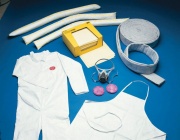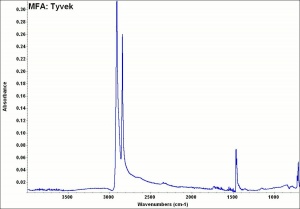Tyvek
Description
[DuPont] A registered trademark for a spunbonded olefin fabric. Tyvek is 100% density polyethylene high density polyethylene with no fillers or binders. It has fine, white, continuous filaments that are bonded by heat and pressure. Tyvek is lightweight, durable, strong, lint-free, and acid-free. The fabric is resistant to wetting, but it allows transmission of moisture and vapors. It is used as a wear resistant, tear resistant, waterproof paper for banners, maps, and envelopes. Applications also include filtration, packaging, bookcovers, interleaving, clean room clothing, protective garments, and carpet backing. Tyvek is commonly seen as a protective barrier in new housing construction. In museums, the high-strength wrapping material is used a soft, lint-free, waterproof liner in packing crates and display cases.
Other Properties
Shrinks at 118 C. Resistant to acids, alkalis and most organic solvents.
Degraded by Freon, pine oil, turpentine, dichloromethane, mineral spirits, ligroin, kerosene, toluene.
Waterproof, acid-free, lint-free, resistant to mold, mildew and insects.
| Melting Point | 135 |
|---|
Hazards and Safety
Chemically stable.
Additional Information
DuPont: Tyvek Website
Additional Images
Authority
- Rosalie Rosso King, Rosalie Rosso King, Textile Identification, Conservation, and Preservation, Noyes Publications, Park Ridge, NJ, 1985
- Book and Paper Group, Book and Paper Group, Paper Conservation Catalog, AIC, 1984, 1989
- Pam Hatchfield, Pam Hatchfield, Pollutants in the Museum Environment, Archetype Press, London, 2002
- Meredith Montague, Meredith Montague, contributed information, 1998
- Website address 1, Website address 1 Comment: AMOL reCollections Glossary -http://amol.org.au/recollections/7/c/htm


